Cider making in Somerset has been a tradition for at least 700 years. An integral part of the farming year, it begins with the apple harvest in late autumn and the pressing of the juice. The unhurried fermentation of the resulting liquid in wooden casks in barns and cellars makes it ready for drinking the following year during the thirsty days of haymaking and harvest. Cider was part of farm labourer’s wages in the 18th and 19th centuries, and although the practice was banned in 1887, it continued to be enjoyed in the fields at harvest time, small half gallon casks called firkins ensuring its safe delivery. The source of the refreshing West Country beverage is not just any sort of apple, but varieties rich in tannins and sugar (bittersweets), or strong in acid (bittersharps). By the 17th century the popularity of Golden Pippin (I. 1629), Bridgwater Pippin (I. c.1665) and others had prompted the renowned horticulturalist, John Evelyn (1620-1706), to describe Somerset cider as ‘generous, strong, and sufficiently heady’. The best was compared favourably with French wines.
To Make Cyder Brandy or Still plain Spirit
Take new Cyder as Soon as it has duly Fermented, and distill it in a Worm twice, the Second time when you put it into the Still, put one third of fair Water, and a large handful of burnt Salt, for that will flux the Spirit, and make it run exceeding fine, then to make it Brandy, you must mix fair water with the Spirit, till you have brought it near about the Strength of Brandy, then to every Gallon of Spirit put two pound of Pruins broke in a Mortar with the Stones, and let it infuse in a Barrel, till you find all the virtue of the fruit in the Spirit When you bottle it to every Gallon put an ounce of Sweet Spirit of Nitre, and Colour it with burnt Sugar, half a pint of burnt Sugar will colour a Hogshead of Brandy or any other Lyquor.
(Manuscript book of remedies and recipes compiled c.1720 by Margaretta Bampfylde [Warre] {SCRO DD/SAS/C795/FA 120})
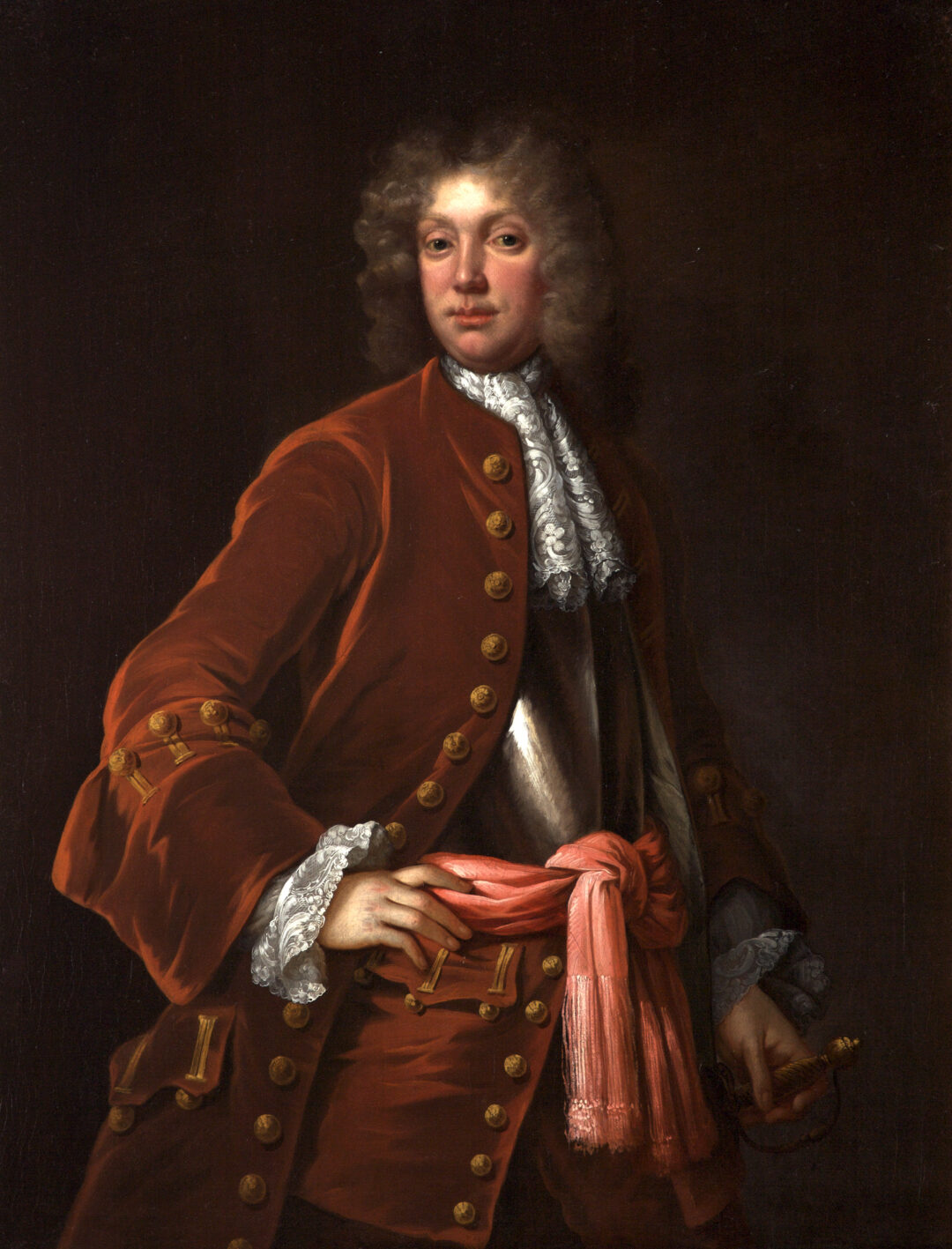
Not surprisingly, the occupants of Hestercombe House also demonstrated a strong penchant for the beverage. From the earliest known reference in December 1698, when Sir Francis Warre paid ‘Grant Briant for Making the Syder’ until the early 1900s when E. W. B Portman established a new 2.4-acre cider orchard in Hestercombe’s southern parkland and replanted Volis Farm’s long-established orchards there is ample documentary evidence to suggest that the estate’s owners looked upon cider as a desirable, if not essential, component of a well-balanced diet. The’17 heads’ that made up the Hestercombe household in the early 18th century benefited from John Bampfylde’s detailed ‘Directions how to order Cyder AD 1720’, savoured the results of Margaret Bampfylde’s recipe ‘To Make Cyder Brandy or Still plain Spirit’, and gratefully received gifts of cider from friends and family.
Among the latter were John Bampfylde’s eldest brother, Sir Coplestone Warwick Bampfylde of Poltimore and his fellow Tory MPs, Sir William Wyndham of Orchard Wyndham, Williton, and Sir Edward Seymour of Maiden Bradley, Wiltshire (who succeeded as Duke of Somerset in 1750.) The fruity beverage was also popular among Hestercombe’s estate workers and tenant farmers, whether as a wage substitute or in lieu of rent. Francis Warre ‘pd Nick Wallis for syder for the coachman towards his Wages’ in March 1697, and there was ‘A Hogshead of Syder for the hedgers’ in March 1698, the same month Francis Warre ‘Recd of N: Wallis in pt of his rent wch will be due Michelmass next A Hogshead of Syder’. Moreover, in January 1722 John Bampfylde ‘Reced of mr Bult in mony & allowd for 8 hogshd & half of Cyder 8:10: wch is in full for his yrs rent for wester coom 15 lib [pounds]’.
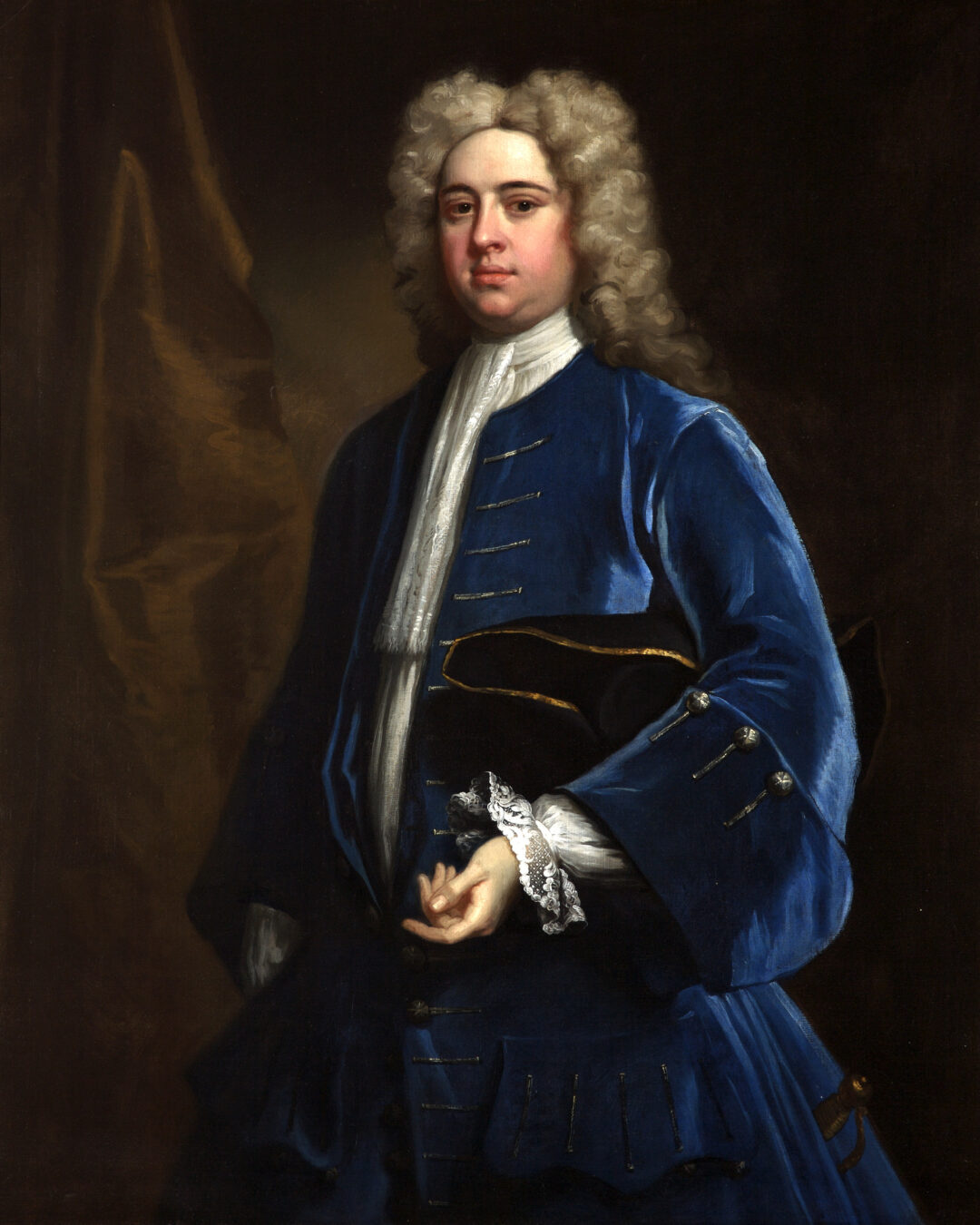
The array of cider making equipment purchased by John Bampfylde in the first half of the 18th century allowed him to stockpile upwards of 2,800 gallons of cider in the cellars of Hestercombe House at any one time. An apple mill obtained in 1720 for the purpose of pressing the fruit was probably water driven and housed in the estate’s 17th century mill. Consisting of a millstone [usually of about a ton in weight] placed upright in a trough, the apple mill ground the fruit to a pulp or ‘pommage’ which was then transferred to a press for layering between mats of reed. The resulting ‘mush’ or expressed liquor was fermented in large wooden casks for six months or more. Bampfylde’s apple mill is mentioned again in the inventory taken following his death in 1750, but it is likely that one existed on the estate as early as 1698 when cider making was first recorded by Sir Frances Warre. As late as 1872 Cider Houses were present on Hestercombe’s two home farms, Volis and Gotten, and the estate’s 17th century mill contained a ‘Cider House and Apple Chamber, fitted with Cider Mill, Corn Mill, with a pair of 3 ft. Stones, both driven by a 11½ ft. over-shot (nearly new) Water Wheel’. The sale of household contents, late the property of Miss Warre, held 8-11 October 1872 included a ‘double iron screw Cider Press’.
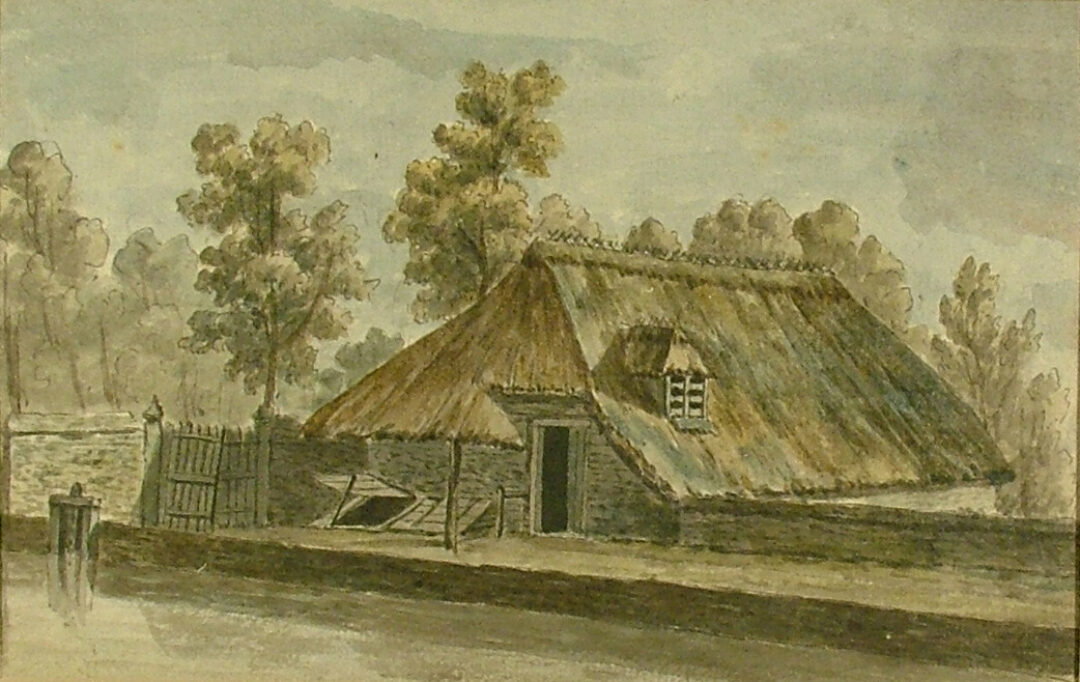
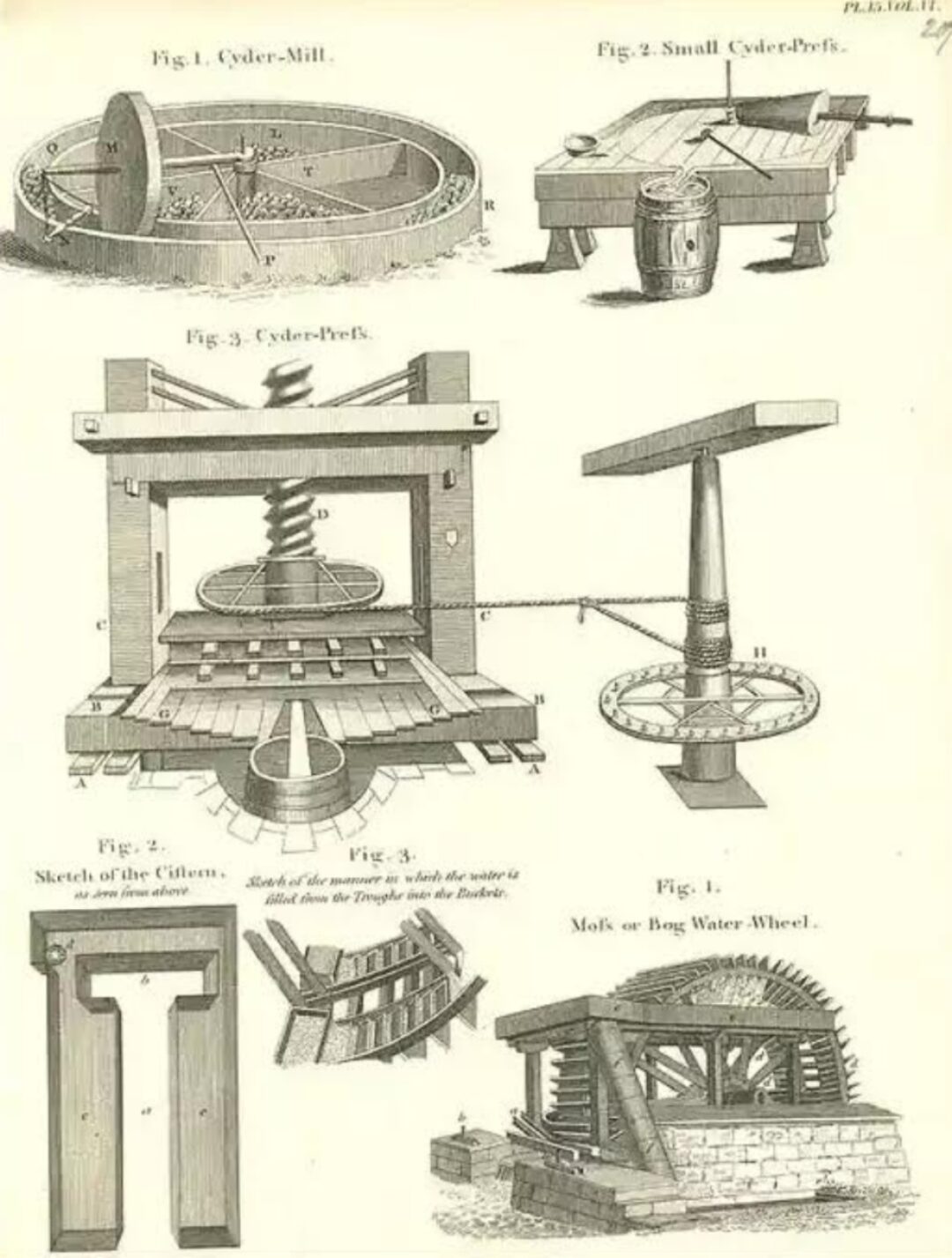
The first recorded mention of ground being devoted to fruit cultivation at Hestercombe is in June 1698 when Francis Warre ‘pd Roger Marsh in pt of 0-9-4 for make fursse fagots & 7 score of fagot wood in the orchard.’ By 1839, 15.31 acres (6.20 hectares) or about 2.0 % of the then 776-acre [314 hectare] property had been given over to apple orchards, a figure that remained almost unchanged until the sale of the estate to Lord Portman in August of 1872 (although 0.34 acres of ground had been turned over to apple cultivation in the kitchen garden by Miss Warre in the intervening years.)
Four orchards, all in hand, accounted for 87% of the total: Higher Orchard (1.44ac) and Lower Orchard (2.13ac) both at Volis Farm; Park Gate Orchard (3.17ac) at Hestercombe’s western entrance; and the Great Orchard (6.58ac) east of Hestercombe House between the Mill and Gotton (The Hon. Mrs. Portman’s favourite apple, the Blenheim Orange, was among the trees grown in the Park Gate Orchard.) Despite the loss of some trees to make way for the building of St. Mary's Church, Hestercombe in 1895, the Great Orchard continued to dominate apple production on the estate into the early 1900s along with the longstanding Warre family orchards at Volis Farm and Park Gate. E. W. B. ‘Teddy’ Portman’s addition of a 2.41-acre plantation in the nearby southern parkland between 1903 and 1911 would be the last major apple orchard to be established on the estate, part of a wider programme of building and agricultural improvement that had begun in December of 1894 just after Teddy and his wife of two years, the Hon. Constance Mary Portman (Lawley), moved to Hestercombe on a permanent basis. In less than a decade the popular country squire established a modern range of Boulton & Paul hothouses in the kitchen garden, improved Volis farm, built an iron clad chapel (St. Mary’s Church), erected a well-appointed Keeper’s Cottage, extended the mill building to include a Dynamo House, and added a cricket pitch, model dairy and two new gate lodges (South Lodge & Middle Lodge).
To keep and preserve as a garden and orchard of 42 trees respectively in good order and proper condition such parts of the demised premises as are now used as garden and orchard respectively. {Clause ii 3 (B), lease of Hestercombe House and 12 acres including the Formal Garden to Somerset County Council by the Crown Land Commissioners, Sept 1953.}
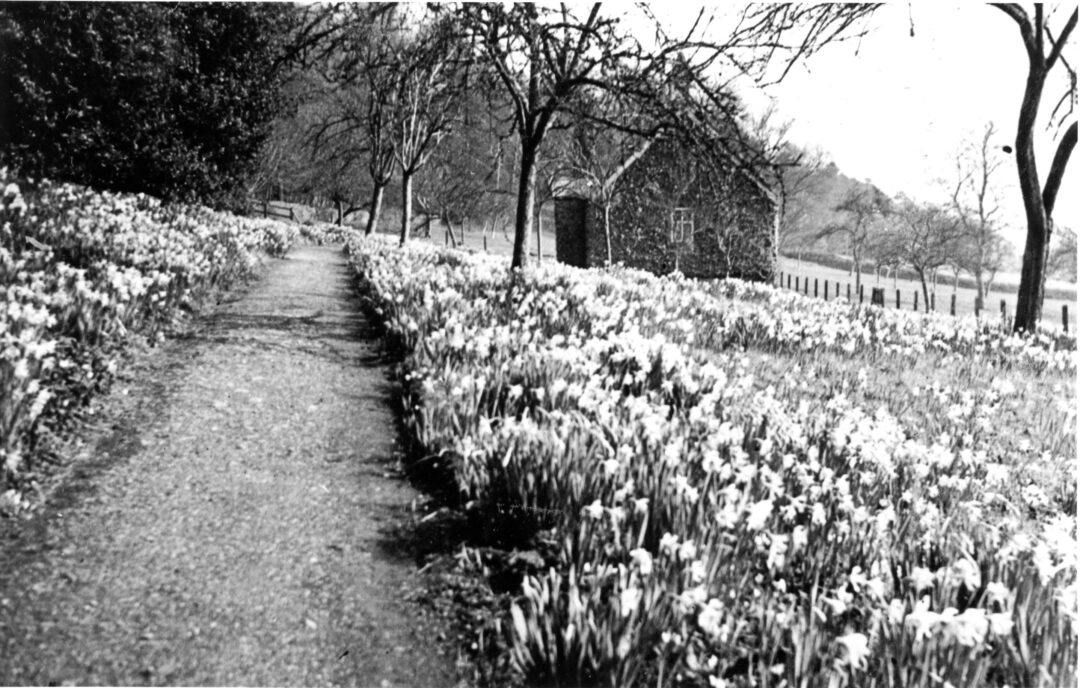
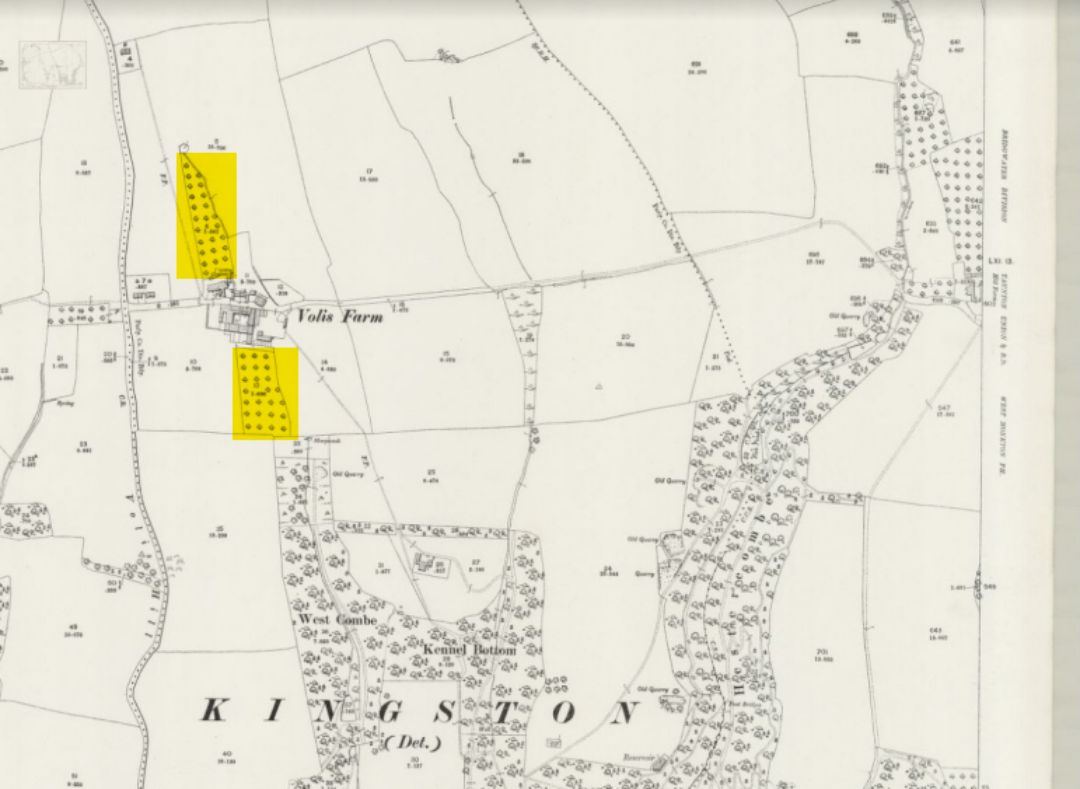
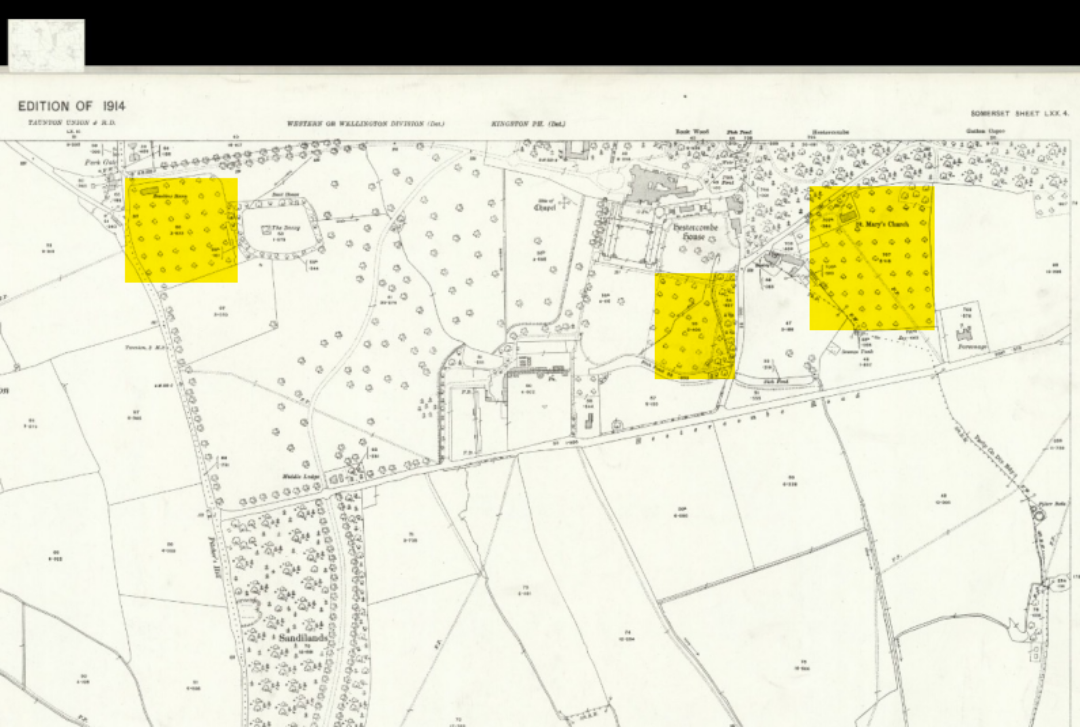
In ‘CIDER--MAKING, OLD AND NEW, published by Country Life 17 October 1908 [Vol. XXIV--No 615: 514-16] a reversal in the fortunes of cider apple orchards in Somerset was formally acknowledged, quoting a new Board of Agriculture leaflet on the subject: ‘The majority of the existing orchards have long passed their best days and are now dying out; and few are being planted to fill their places.’
For a time Hestercombe’s orchards appear to have resisted the general trend being maintained to a fairly high standard. The lease for Volis Farm, dated 21 October 1911, for example, stipulated that the tenant farmer (Robert Mead) ‘keep and leave the gardens and orchards well and sufficiently stocked and to keep all the apple and other fruit trees growing thereon properly pruned and protected’. Forty-eight new apple trees were planted at Volis during the term of the lease. However, as the century wore on the Hestercombe orchards were increasingly neglected, the premature death of Teddy Portman in 1911 and two world wars taking their toll. Today only the Portman Orchard remains. Most of the 42 trees mentioned in the 1953 lease between Somerset County Council and the Crown Estate Commissioners eventually died out, the demands of maintaining Hestercombe House while restoring the renowned Formal Garden by Edwin Lutyens and Gertrude Jekyll initially taking priority.
Replanting of the Portman Orchard finally began in 1990, first under the auspices of Somerset County Council (1990-95) and more recently the Hestercombe Gardens Trust (2012 & 2021). Research into suitable heritage apples by the two organisations has resulted in a varied palette of fourteen different varieties, bearing dessert, cider and cooking qualities. With one exception, the trees date from before 1900.
The Portman Orchard: Apple Trees Jan. 2023
Ashmeads Kernal | developed from seed planted 1720 at Ashmeade House, Glocs; grown commercially from late 1700s | Culinary, Cider, Dessert, |
Blenheim Orange | discovered as seedling at Blenheim Palace 1740; renamed 1804 and grown commercially thereafter | Culinary, Cider, Dessert, |
Bramley Seedling | discovered Southwell, Nottinghamshire c.1809; introduced 1865 by Henry Merryweather & Son | Culinary, Cider, Dessert |
Charles Ross | developed late 1800s at Welford Park Gardens, Newbury, Berkshire; introduced 1890 | Cooking, Cider |
Court Pendue Plat | documented growing in Normandy early 1400s; widely cultivated throughout 1600s | Dessert |
Dabinett | discovered as hedgerow seedling by William Dabinett early 1900s near Martock-Kingsbury, Somerset | Cider |
D’Arcy Spice | discovered as seedling at Toleshunt D’Arcy Hall, Colchester, Essex 1785; available for sale by 1848 | Dessert, Juice |
Duke of Devonshire | developed at Holker Hall, Cumbria 1830s; available in nurseries by 1860 | Dessert |
Egremont Russet | raised at Lord Egremont’s estate, Petworth, Sussex; first listed by Scott's Nursery, Merriott, Som., 1872 | Cider, Dessert |
Fair Maid of Taunton | probably originated in Taunton, Somerset; described in horticulture texts from 1832 | Cider, Dessert |
Golden Knob | raised at Enmore Castle, Enmore, Somerset, late 1700s | Cider, Dessert |
Golden Pippin | discovered Arundel, Sussex, before 1600; described by John Parkinson 1629 and well known by the 1700s | Culinary, Cider, Dessert |
Kingston Black | probably raised at Kingston St Mary, Somerset; widely available by early 1800s | Cider |
Winter Pearmain | grown in England since the Middle Ages | Culinary, Dessert |